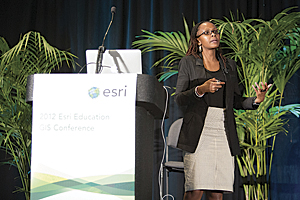ArcUser
Fall 2012 Edition
Entering a New Era in GIS Education
This article as a PDF.
Community was the focus of the 2012 Education GIS Conference, and more than 700 members of the GIS education community, a record number, turned out for the event held July 21–24, 2012, in San Diego, California.

Juliana Rotich, cofounder and executive director of Ushahidi, spoke on the mobile future of crowd mapping.
In his plenary address, David DiBiase, Esri's director of education industry solutions, introduced the conference theme, Education Community 20.2: The Next Generation of GIS Education. DiBiase noted that 2012 marks the 20th anniversary of several events of importance to GIS educators. Not only was 1992 the year in which the first commonly available web browser with a graphical user interface was released, it was also the year Michael Goodchild coined the term geographic information science, the year ArcView 1.0 was released, and the year the Esri Education Program was started.
DiBiase asked the audience to reflect on how much GIS education has changed since 1992. The convergence of three trends—ease of use, pervasive mapping technologies, and democratization of education through cloud-based media platforms that make learners both producers and consumers of educational resources—is now making a new era in GIS education possible. The challenge is harnessing these trends to improve educational access and quality.
In response to this challenge, DiBiase announced the meeting of the first GIS Education Community Advisory Board during the conference. The board's purpose is to help Esri's education team align its priorities with those of the GIS education community's. Esri is committed to supporting the community of both learners and educators.
Juliana Rotich, cofounder and executive director of the nonprofit technology company Ushahidi, also spoke to the democratization of GIS education in a presentation entitled "Crowd-mapping, Citizen Science, and Participatory Learning."
Ushahidi means "testimony" in Swahili. The company, based in Nairobi, Kenya, supports map-based, crowdsourced data collection for the democratization of information. Ushahidi's work is self-perpetuating. Projects spring up that are self-organizing, self-run, and self-sustaining. Esri, a longtime supporter of Ushahidi, recently released an ArcGIS add-in for the Ushahidi platform.
Said Rotich, "I think the future for mapping crowdsourced data is decidedly mobile. It will be a mix of mapping systems and crowd- sourcing systems with interfaces that are simple, so that regular people can quickly and easily provide and access relevant data."
The Education GIS Conference attendees also enjoyed nearly 100 user presentations, workshops, learning labs, and special interest group meetings as well as the GIS Solutions EXPO, which included many of Esri's education partners. The conference extended into the Esri International User Conference at the San Diego Convention Center with the Academic GIS Program Fair, featuring the GIS programs of a number of colleges and universities and Youth Community GIS, which highlighted student work.
Planning for the 2013 Education GIS Conference has already begun and education community members—including educators, education researchers, learning designers, administrators and staff, and especially learners of all ages—are encouraged to make plans now to attend.